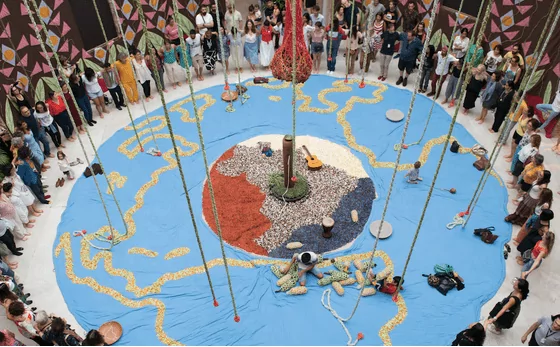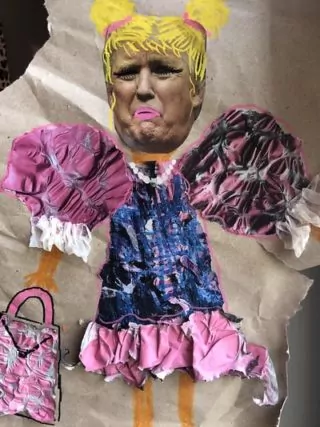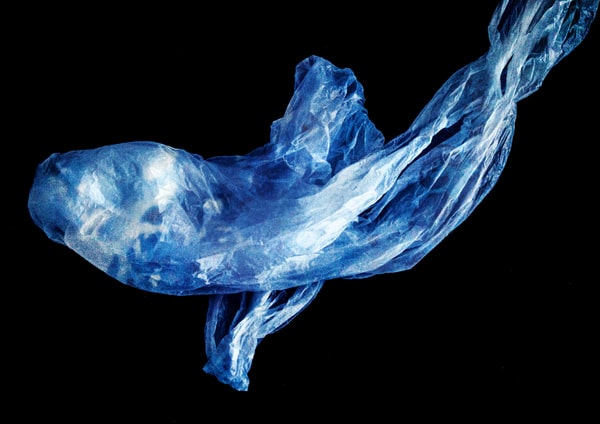
By Eleonora Cerasoli
Sustainability has been at the centre of the fashion and beauty industry for quite a while now, with zero waste beauty initiatives, the rise of slow fashion and sustainable furniture and homeware. With our culture taking action towards change, the art world is joining the conversation on sustainability. Let’s turn the spotlight to the art scene, to explore what the art world has done or is doing for our planet.
Can artists make a difference in the fight against climate change and environmental degradation? Sustainability may be enrooted in artists’ practices more than we think, and the contemporary art scene is signalling that sustainability may be the future of the art world.
What is sustainable art?
Sustainable art can be simply defined in two different yet sometimes interconnecting ways: art made using sustainable materials and methods, or art that encourages conversation on sustainability. Sustainable art is about creativity to find new ways to make art that can benefit the environment, whether that is by using accessible and natural materials, or by inspiring social awareness on pressing issues.
Before diving into artists practices and artworks that are making a difference let’s talk about one of the most controversial realities of the art world: art biennials.
Art Biennials: a danger to the planet?
In 2021, the Biennial Foundation’s directory listed over 270 cities that host a bi-yearly art event. It’s alarming to think about the environmental repercussions of a staggering number of events generating very high carbon’s emission (with concentrated international tourism) and leaving behind incredible amounts of waste.
Biennials are more than just art exhibitions occurring every two years, they “have become structural within the contemporary visual arts exhibitionary complex” says art critic Terry Smith. The increased number of biennials brought to coin the term “biennialisation”, a neologism that reveals the event-based nature of the art world. The temporariness of the event is the reason for its success, with art presented at a specific time and place, despite not holding any connection with the location.
Since their origins in the mid 19th century, as Salons and Exposition Universelles (“universal exhibitions”), these events are essential opportunities to draw attention to artists, providing them with the infrastructure to work and survive. They play a key role in shaping fields on interests at national and international levels, but it’s fair to say that biennials have been unevenly experienced as “global” events, with Western European and North American artists dominating the spotlight.
Can Art Biennials be sustainable? The Helsinki Biennial
The contemporary art event Helsinki Biennial is setting the example for future international exhibition as a climate-neutral event. It opened to the public on June 12, taking place in the historical natural environment of Vallisaari Island, presenting 41 artists and artist groups working across a variety of media.
Only using 20% of the land and placing artworks along pre-existing paths, the biennial ensures that the heritage and biodiversity of the territory are not comprised. They adopted tools to measure carbon emissions, from waste to energy consumption, setting an example not only for future biennials but also for museums and art galleries. They use recycled and upcycled bicycles, avoid distributing any unnecessary printed material and ensure their waste is biodegradable. All staff is trained in environmental awareness and an environmental coordinator is part of the team, planning and implementing sustainable practices, measuring progress and highlighting possible improvements.

Sustainability is also part of the exhibitions’ theme. Entitled The Same Sea, the Helsinki Biennial celebrates the interconnection and interdependency of everything on this planet. The title is a metaphor for our current critical ecological situation, which, even though the consequence might vary from one side of the world to the other, brought all of us onto the same sea. Many artists inspired by the unique location and the pressing environmental issues, explored the connection between human and nature.
The bridge between art and sustainability is not only built on the impact art exhibitions have on our planet. For many decades now, artists dedicated their art to highlight environmental issues. Across many media and time periods, artists of all nationalities used their creativity to defined sustainable art by using upcycled materials, reclaimed objects and natural resources to create artworks that not only wouldn’t damage the environment but would also celebrate it and protect it.
Environmental Art movement
This new approach to art emerged at the end of the sixties to raise awareness and inspire communication on the dangers our planet is facing. Artists across all media create art to encourage commitment to fight global warming and its impact on our planet, fighting for its conservation.
Land Art
A contemporary art form born in the United States at the end of the sixties, considering the intervention of the artist on the surrounding environment as an essential part of the artwork. It reflects the relationship between human and nature, making the environment not only the subject of the artwork but also the matter of the work itself.
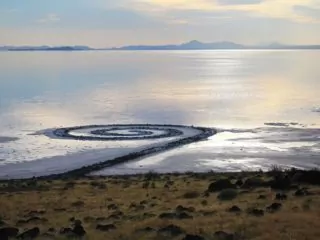
Arguably the most famous example of Land Art, Spiral Jetty is a temporary work of art created by American artist Robert Smithson (1938-1973). A giant spiral in the Great Salt Lake (Utah) made of 5000 tons of basalt (a dark rock formed by cooled lava). The work is the perfect example of Land Art, as it not only uses natural materials but is inspired by the environment it occupies and becomes one with its natural surrounding.
Land Art led to the development of more explicitly sustainable movements:
Ecological art
A form of functional art focusing on activism and the restoration of the environment. This movement not only highlights environmental issues but it researches new ways to co-exist with the environment.
Bio Art
An artistic movement not primarily focused on sustainability issues but more on the type of materials employed and the techniques developed to create artworks. Bio artists use natural materials, sometimes including live tissue, bacteria, and other living organisms. Other artists create works from materials previously deemed unusable and unwanted like discarded plastic, recycled or reclaimed materials.
Eco Design
It consists of making objects taking into consideration their whole lifecycle, anticipating the impact they will have on the environment, from using materials sourced with minimum environmental impact to reduce as much as possible the production of waste and pollution during the manufacturing and distribution process.
These days, sustainability is the foundation of the practice of many artists who are finding ways to create art with the world they live in, rather than just within it. We want to share some of our favourite sustainable art initiatives from artists who, experimenting across media, are making a difference for our planet.
Our favourite sustainable art initiatives
Gender equality, affordable and clean energy, climate action are only a few of the 17 Global Goals set in 2015 by world leaders at the United Nations in the 2030 Agenda for Sustainable Development. Can art play a role in this ambitious and transformative plan for the planet and the people?
ART-2030, a non-profit organization, decided to work with world-renowned artists and partners as the key to achieve the UN Global Goals. They organize art projects, including public events, art experiences and education activities to inspire action for a sustainable future.
Cura Bra Cura Té – Ernesto Neto
In this art installation that roughly translates into “cure Bra(zil), cure thyself”, Neto’s sensorial work transforms the viewer into the participant. The central installation covers the Octagon hall of the Sao Paulo museum and becomes a gathering place where celebration and contemplation coexist. The work is hand-woven with a crochet technique used by the indigenous community of Hui Kuin inhabiting the forest. Neto has been supporting Brazilian indigenous communities by partnering with them in several works.
“The indigenous peoples of the forest have a much deeper connection to nature. In actual fact, the word ‘nature’ as something that lies outside of us human beings doesn’t even exist in this community. They cannot make sense of this separation” – Ernest Neto
The Loughborough University propose a wonderful project visually challenging our use of plastic, raising awareness on its impact on the environment throughout its entire lifecycle, from manufacture to disposal. These inspiring artworks aim to challenge our choices and prompt a shift in our behaviours towards the use of plastic.
The work of Issy Spurway analyse the issues with fast fashion and more specifically with “throwaway culture”. The increasing waste of textile from Western countries is jeopardising the growth of small textile businesses. Some companies are exploring new alternatives to synthetic materials (as recycled plastics) to reverse some of the damage the fashion industry has done to our planet. The powerful image, made from manipulated recycled plastic, is a political statement condemning Trump’s harmful attitude towards climate change.
The artist challenges the viewer with a powerful image of a plastic bag-made whale, manipulating this controversial material, experimenting with different media to denounce the alarming amount of plastic polluting our oceans and endangering marine wildlife.
The rhythm of breathing guides the strokes of the watercolours to create a repetitive pattern of vertical blue stripes, painted on white paper or wall. The artist involved visitors in this project for them to experience their breath, body and mind in the present, and as a meaningful moment with their environment.
The Breath With Me initiative aligns with the United Nations’ global call to action on climate change, in particular, the Clean Air Initiative to improve air quality for the entire population, and more widely to urge governments to improve people’s health, reduce inequalities, promote social justice and protect the climate for future generations.
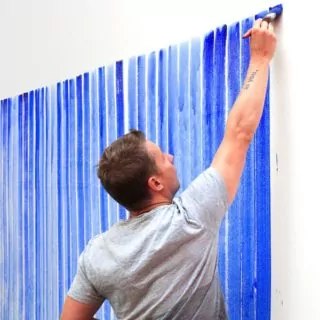
“ Life begins with an inhale and ends with an exhale. In-between we all breathe and live different lives. And yet, each breath keeps us together, connected, sharing the same air. ” – Jeppe Hein
The art scene offers many more examples of artists making a difference, raising awareness on pressing environmental issues and putting sustainability at the core of their art. Let us know in the comments if you have any recommendation for sustainable art initiatives and what is your opinion on the role the art world should have in the fight to protect our planet!
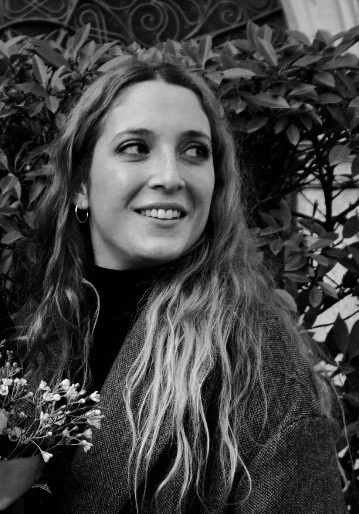
Eleonora Cerasoli
Eleonora is an Italian art historian and enthusiast based in London. Inspired years ago to make a change and live a more sustainable life, she now wants to empower readers through her writing. "One book, one pen, one child, and one teacher can change the world."
